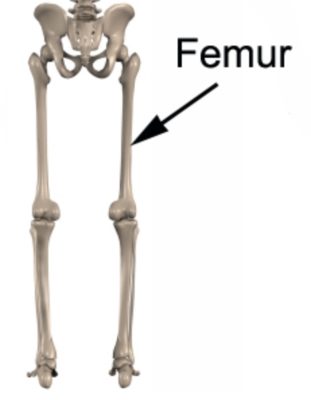Femur Anatomy
Updated:
As the longest bone in the human body, the femur plays a critical role in human movement and stability. Understanding the anatomy of the femur is essential for diagnosing and treating injuries and conditions related to this bone. In this article, we will discuss the bony landmarks, muscular attachments, and common injuries associated with the femur.
Femur Anatomy – Bony Landmarks
The femur is the only bone of the thigh and (Figure 1) has several important bony landmarks. The head of the femur is the rounded top portion that articulates with the hip socket to form the hip joint. The neck of the femur is the narrow region just below the head, and the greater and lesser trochanters are the bony protrusions on the side of the femur. The shaft of the femur is the long, straight portion that extends from the trochanters to the knee joint.

Femur Anatomy – Muscular Attachments
The femur has numerous muscular attachments that allow for movement and stability. The quadriceps muscles attach to the top of the femur, just above the knee joint, and allow for knee extension. The hamstrings attach to the back of the femur and allow for knee flexion. The gluteus medius and gluteus minimus muscles attaches to the greater trochanter of the femur and allows for hip abduction (sideways movement of the hip), rotation and stabilisation of the pelvis during single leg stance.
Common Injuries affecting the Femur
Injuries to the femur can be severe and potentially life-threatening. Fractures, dislocations, and sprains are common injuries associated with the femur. Femur fractures can occur from high-impact trauma, such as a car accident or fall from a height, and can result in significant pain, swelling, and immobility. Dislocations of the hip joint can occur from a traumatic event and can cause severe pain and difficulty with movement. Sprains, which involve the tearing or stretching of ligaments, can occur from overuse or trauma and can result in pain and instability. Injuries affecting the muscles or soft tissue attaching to the femur are also very common and may including injuries such as quadriceps strains, hamstring strains, hip flexor strain, trochanteric bursitis, MCL tear, LCL tear etc.
Physiotherapy for Femur Injuries:
Physiotherapy can play a critical role in the recovery process for injuries affecting the femur and surrounding soft tissue (muscles / ligaments etc.). Treatment may involve exercises to increase strength and range of motion, as well as manual therapy techniques to reduce pain and improve joint mobility. Additionally, physiotherapists may recommend assistive devices, such as crutches or braces, to support the injured area during the healing process.
In conclusion, understanding the anatomy of the femur is crucial for identifying and treating injuries and conditions related to this bone. The bony landmarks, muscular attachments, and common injuries associated with the femur provide a framework for healthcare professionals, including physiotherapists, to diagnose and treat these injuries. If you experience pain or discomfort in your femur, it is important to consult with a healthcare professional to determine the cause and best course of treatment.
References:
- Femur Anatomy by Teach Me Anatomy: The Femur – Proximal – Distal – Shaft – TeachMeAnatomy
- Moore, K. L., Dalley, A. F., & Agur, A. M. (2013). Clinically oriented anatomy. Lippincott Williams & Wilkins.
- Netter, F. H. (2014). Atlas of human anatomy. Elsevier Health Sciences.
- Standring, S. (Ed.). (2016). Gray’s anatomy: the anatomical basis of clinical practice. Elsevier Health Sciences.
- Hamid, N., & Dar, A. (2012). Femur shaft fractures: current concepts. Indian Journal of Orthopaedics, 46(2), 129-138. doi: 10.4103/0019-5413.93694
- Bennell, K. L., & Crossley, K. (2018). Musculoskeletal injuries in track and field: incidence, distribution and risk factors. Australian Journal of Science and Medicine in Sport, 21(3), 74-79.

Link to this Page
If you would like to link to this article on your website, simply copy the code below and add it to your page:
<a href="https://physioadvisor.com.au/femur-anatomy”>Femur Anatomy – PhysioAdvisor.com</a><br/>Learn about femur anatomy including bony landmarks, muscular attachments, common injuries and more on PhysioAdvisor.
Return to the top of Femur Anatomy.
